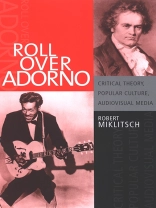What happens when Theodor Adorno, the champion of high, classical artists such as Beethoven, comes into contact with the music of Chuck Berry, the de facto king of rock ‘n’ roll? In a series of readings and meditations, Robert Miklitsch investigates the postmodern nexus between elite and popular culture as it occurs in the audiovisual fields of film, music, and television—ranging from Gershwin to gangsta rap, Tarantino to Tongues Untied, Tony Soprano to Buffy the Vampire Slayer, Miklitsch argues that the aim of critical theory in the new century will be to describe and explain these commodities in ever greater phenomenological detail without losing touch with those evaluative criteria that have historically sustained both Kulturkritik and classical aesthetics.
Содержание
List of Illustrations
Acknowledgments
Script
INTRODUCTION: CRITICAL THEORY, POPULAR CULTURE, AUDIOVISUAL MEDIA
Popular Music
Sound Film
Television
Part 1. Popular Music: Hi-Lo Fidelity
1. ROCK ‘N’ THEORY: CULTURAL STUDIES, AUTOBIOGRAPHY, AND THE DEATH OF ROCK
A Side: The Birth of Rock, or Memory Train
B Side: Rock in Theory
The Culture of Rock
Rock, Rap, and Riot Grrrls
World Musics: After Rock Imperialism
Production of Culture
Forced Choice: Britney or Avril?
My Generation
2. ROLL OVER ADORNO: BEETHOVEN, CHUCK BERRY, AND POPULAR MUSIC IN THE AGE OF MP3
Mass Culture, Ersatz Kantianism
From Beethoven to Fascism
Amerika: Beethoven or Bikinis
Radio Days
“Roll Over Beethoven”
Magic Spell and the Two Spheres of Music
MP3
Fantasia
REPRISE: BEETHOVEN’S HAIR
Part 2. Sound Film: Screen Theory and Audiovisuality
3. THE SUTURE SCENARIO: AUDIOVISUALITY AND POST-SCREEN THEORY
Theory: The Suture Scenario
Post-Screen Theory: Suture-as-Desuturing
Audiovisuality in Tongues Untied and Set It Off
Illustration A: Tongues Untied
“Lover Man”: Lady Day/Blue Boy
En Vogue
Illustration B: Set It Off
Cleopatra Jones Redux: Queen Latifah as Gangsta Butch Diva
G-Funk: Girlz N the Hood
Crossroads
4. AUDIOPHILIA: AUDIOVISUAL PLEASURE AND NARRATIVE CINEMA IN JACKIE BROWN
Cinephilia
Scopophilia
From Scopophilia to Audiophilia: The Gaze qua Race
Audiophilia: Auditing Jackie Brown
“Across 110th Street”: Overture
“Street Life”: Jackie as Femme Noire
“Across 110th Street”: Dénouement
Audiophilia Reconsidered: “Asking for It”
Counterpoint: Post-Soul Music or Pre-Gangsta Rap?
REPRISE: ALEX’S “LOVELY LUDWIG VAN” AND MARTY MCFLY’S WHITE ROCK MINSTREL SHOW
Part 3. TV: Television, Telephilia, Televisuality
5. GEN-X TV: POLITICAL-LIBIDINAL STRUCTURES OF FEELING IN MELROSE PLACE
PREVIEW
After the Reagan Dynasty: “Help Me, Rhonda”
From Race to Sex-Gender: Kiss Kiss, Bang Bang
The Romance of Capital: Fox, Female Address, and Postfeminism
Melrose Space: The Fashion Mode
Adcult: The Commercial Supertext
Review
6. SHOT/COUNTERSHOT: SEXUALITY, PSYCHOANALYSIS, AND POSTMODERN STYLE IN THE SOPRANOS
Shot: The Godfather
Citationality: The Gangster as Serio-Comic Hero
“I’m a Man”: Crossing Cultures
Psycho-Gangster TV: Seriality and Self-Reflexivity
A la Recherche du temps perdu
Primal Scene: Capicola as Proustian “Tea Cookie”
Countershot: Case Study
Black and Blue: Puzo’s Women
Repetition Compulsion: From The Godfather to The Sopranos
Beyond the University
Post-Mortem: Bad Love
D-I-S-R-E-S-P-E-C-T: Tele-Psychoanalytic Metatext
Après Coup: Analysis Interminable
Martini Shot: “Hall Hath No Fury”
REPRISE: TONY SOPRANO, MEET BUFFY THE VAMPIRE SLAYER
Notes
Bibliography
Index
Об авторе
Robert Miklitsch is Associate Professor of Critical Theory at Ohio University. He is the author of
From Hegel to Madonna: Towards a General Economy of ‘Commodity Fetishism, ‘ also published by SUNY Press.












